Campus Martius
1998.07.12
- the Field of Mars
- a place of assembly for the Roman people at the comitia centuriata; also, much resorted to by the Romans for games, exercise, and recreation, a place for military drills, etc.
Within his archeological publication Il Campo Marzio dell'Antica Roma, Piranesi wrote a history of the Campus Martius. The text, which is written in six chapters and supplemented with extensive footnotes, is both factual and polemical, and, for the most part, relates directly to the various maps and perspectives within the same publication. (The Ichnographia comprises six of Il Campo Marzio dell'Antica Roma's forty-nine plates.) The history itself is based on numerous ancient texts, as well as some Renaissance texts. It is interesting to note, moreover, that 20th century archeology, even though many more physical remains within the Campo Marzio are now unearthed, still relies heavily on the same ancient texts. It thus becomes arguable whether Piranesi's text is due more archeological credit than it generally receives.
The Il Campo Marzio text is written in Italian, and presently no English translation exists.
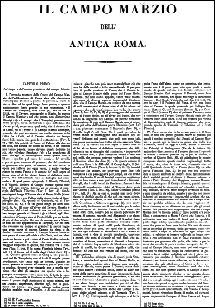
The first page of Piranesi's history of the Campo Marzio.
overall, one very Piranesian daze
2000.04.06
...the first documentation of the heretofore undetected two differing published states of Piranesi's Ichnographia Campus Martius, the six fold-out plates that comprise a reenactment plan of ancient Rome within Piranesi's larger Il Campo Marzio dell'antica Roma 'archaeological' publication. After many years of redrawing and analyzing a printed reproduction of the Ichnographia, I went, on May 14, 1999, to see an original version of the Ichnographia at the University of Pennsylvania's Fine Arts Library. Within minutes of having a 'real' Ichnographia unfolded in front of me, I noticed that the Circus of Caligula and Nero is not only labeled, but also configured somewhat differently than the circus plan I was used to seeing. Of course, I was instantly very excited because nowhere have I ever read about the Ichnographia having two editions/states (like Piranesi's Carceri/Prisons have two published states/editions), and these two different plans are definitely not noted within Wilton-Ely's recent Giovanni Battista Piranesi - The Complete Etchings. Moreover, I believe I discovered something that no other architect, architectural historian, or art historian had noticed before. I then quickly scanned the rest of the plan to see if any other differences existed, and, sure enough, the Circus Agonalis is likewise different than the plan commonly reproduced. On 4 April 2000, I finally returned to Penn's Fine Arts Library to document the two different Ichnographia via tracings and taking digital images:
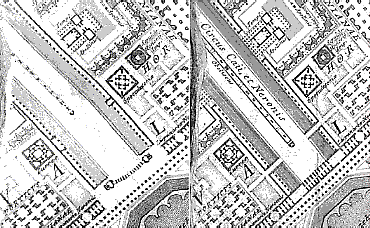
The image above left is the Circus of Caligula and Nero as the Ichnographia is commonly reproduced. The image above right is the Circus of Caligula and Nero as it appears within the University of Pennsylvania's (original) copy of the Campo Marzio.
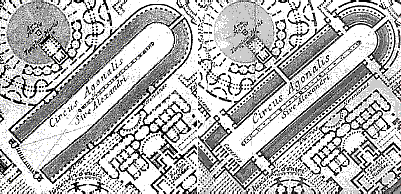
The image above left is the Circus Agonalia as the Ichnographia is commonly reproduced. The image above right is the Circus Agonalia as it appears within the University of Pennsylvania's (original) copy of the Campo Marzio.
The differing plans raise several questions:
Did Piranesi himself make these changes, or did perhaps his son Francesco, and if Piranesi made them, then why?
Which set of plans were 'drawn' first?
Does this 'change of plan' carry any possible semiotic or symbolic message regarding the Ichnographia's larger meaning?
Does this physical evidence offer any indication of Piranesi's 'design' method?
| |
more of Piranesi's Campo Marzio
2001.07.01 09:05
You mentioned that you are not familiar with Piranesi's full Il Campo Marzio Dell'antica Roma publication. While its engravings are recently (and nicely) reproducted in both Wilton-Ely's and Ficacci's (Taschen) Piranesi: Complete Etchings, the texts that Piranesi wrote have to my knowledge never been republished (except for a facsimile publication of Il Camp Marzio by Borsi, 1972). The text is a history of the Campus Martius in both Latin and Italian, plus there is a list of extant ruins and a ' Catalogo', which is a bibliography of sorts -- what it does is list all the buildings that were in the Campo Marzio and matches them with their literary sources (both ancient and contemporary). Since I cannot read either Latin or Italian, the texts are for the most part inaccessible to me. The 'Catalogo', however, is for the most part discernable to me, and thus a great source into finding out what Piranesi was really up to when he 'reconstructed' (I refer reenacted) the Campo Marzio with the Ichnographia.
Re: lack of life
2002.01.19 11:46
...to learn more of Honorius (the younger son of Theodosius who is now Emperor of the West) and his wife Maria. Honorius was the last ancient ruler to [re]build the walls of Rome (because of the "Gothic Wars" -- Christian "Goths" that is) and he also built an imperial mausoleum attached to the original Basilica of St. Peter's. Sometime in the 1500s the sarcophagus of Maria was discovered (very likely while the old basilica was being demolished to make way for the new/present one). The sarcophagus of Maria may well be the last substantial imperial artifact of (the city of) Rome, and after an illustrious title page and a frontispiece, it is an image of the sarcophagus of Maria that Piranesi uses to begin his Campo Marzio publication. In a most elegantly covert way, Piranesi began the 'history' of the Campo Marzio with what is really it's ending, and what is probably the world's greatest designed architectural inversionary double theater goes on from there.
Re: paper architectures
2002.02.20 11:29
B.'s wondering about text (on paper, etc.) architectures makes me want to relate something I found out about the architecture of ancient Rome (particularly the Campo Marzio). An index at the end of Piranesi's Il Campo Marzio publication entitled "Catalogo" lists all the buildings known to have existed in the ancient Campus Martius, and the name of each building is accompanied by the literary (i.e., textual) references within ancient writings where mention of the respective buildings occurs. What is interesting is that eventually I learned (via long assimilation, if not also osmosis) that the only 'real' evidence left of many ancient Roman buildings is their mention in texts. Even within today's archaeology there are no physical remains for lots of 'known' ancient Roman buildings. Of course, there is apparently a lot still buried under later buildings, but one can still (now) think of much of today's 'paper architectures' as the inverse reflection (in a 'quondam' mirror?) of much of ancient Rome's architectures.
Brideshead Revisited
2005.08.05 13:00
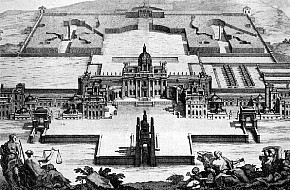
I'm now wondering whether the above image of Castle Howard from Vitruvius Britannicus (published 1715-1725) somehow inspired the architecture of Piranesi as delineated within Il Campo Marzio (1762). Remember the Ichnographia of the Campo Marzio (1757-62) is dedicated to Robert Adam. Did Adam show Piranesi Vitruvius Britannicus while he (Adam) was friends with Piranesi in Rome in the 1750s? In any case, the perspectival vantage point and indeed the architecture depicted within the perspectives of the Campo Marzio very much evoke the Castle Howard aerial perspective, for example the Frontispiece of the Campo Marzio:
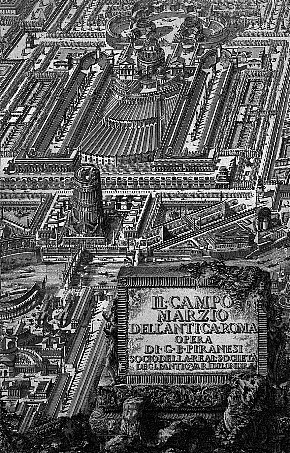
|